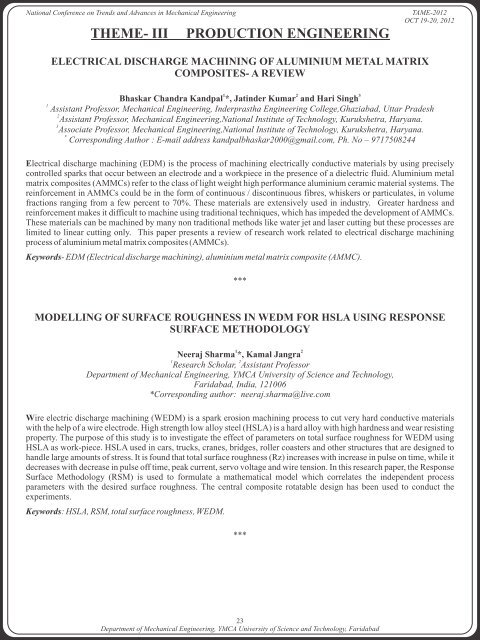Souvenir Containing Abstracts - YMCA University of Science ...
Souvenir Containing Abstracts - YMCA University of Science ...
Souvenir Containing Abstracts - YMCA University of Science ...
Create successful ePaper yourself
Turn your PDF publications into a flip-book with our unique Google optimized e-Paper software.
National Conference on Trends and Advances in Mechanical Engineering<br />
THEME- III<br />
PRODUCTION ENGINEERING<br />
TAME-2012<br />
OCT 19-20, 2012<br />
ELECTRICAL DISCHARGE MACHINING OF ALUMINIUM METAL MATRIX<br />
COMPOSITES- A REVIEW<br />
1 2 3<br />
Bhaskar Chandra Kandpal *, Jatinder Kumar and Hari Singh<br />
1<br />
Assistant Pr<strong>of</strong>essor, Mechanical Engineering, Inderprastha Engineering College,Ghaziabad, Uttar Pradesh<br />
2<br />
Assistant Pr<strong>of</strong>essor, Mechanical Engineering,National Institute <strong>of</strong> Technology, Kurukshetra, Haryana.<br />
3<br />
Associate Pr<strong>of</strong>essor, Mechanical Engineering,National Institute <strong>of</strong> Technology, Kurukshetra, Haryana.<br />
*<br />
Corresponding Author : E-mail address kandpalbhaskar2000@gmail.com, Ph. No – 9717508244<br />
Electrical discharge machining (EDM) is the process <strong>of</strong> machining electrically conductive materials by using precisely<br />
controlled sparks that occur between an electrode and a workpiece in the presence <strong>of</strong> a dielectric fluid. Aluminium metal<br />
matrix composites (AMMCs) refer to the class <strong>of</strong> light weight high performance aluminium ceramic material systems. The<br />
reinforcement in AMMCs could be in the form <strong>of</strong> continuous / discontinuous fibres, whiskers or particulates, in volume<br />
fractions ranging from a few percent to 70%. These materials are extensively used in industry. Greater hardness and<br />
reinforcement makes it difficult to machine using traditional techniques, which has impeded the development <strong>of</strong> AMMCs.<br />
These materials can be machined by many non traditional methods like water jet and laser cutting but these processes are<br />
limited to linear cutting only. This paper presents a review <strong>of</strong> research work related to electrical discharge machining<br />
process <strong>of</strong> aluminium metal matrix composites (AMMCs).<br />
Keywords- EDM (Electrical discharge machining), aluminium metal matrix composite (AMMC).<br />
***<br />
MODELLING OF SURFACE ROUGHNESS IN WEDM FOR HSLA USING RESPONSE<br />
SURFACE METHODOLOGY<br />
1 2<br />
Neeraj Sharma *, Kamal Jangra<br />
1 2<br />
Research Scholar, Assistant Pr<strong>of</strong>essor<br />
Department <strong>of</strong> Mechanical Engineering, <strong>YMCA</strong> <strong>University</strong> <strong>of</strong> <strong>Science</strong> and Technology,<br />
Faridabad, India, 121006<br />
*Corresponding author: neeraj.sharma@live.com<br />
Wire electric discharge machining (WEDM) is a spark erosion machining process to cut very hard conductive materials<br />
with the help <strong>of</strong> a wire electrode. High strength low alloy steel (HSLA) is a hard alloy with high hardness and wear resisting<br />
property. The purpose <strong>of</strong> this study is to investigate the effect <strong>of</strong> parameters on total surface roughness for WEDM using<br />
HSLA as work-piece. HSLA used in cars, trucks, cranes, bridges, roller coasters and other structures that are designed to<br />
handle large amounts <strong>of</strong> stress. It is found that total surface roughness (Rz) increases with increase in pulse on time, while it<br />
decreases with decrease in pulse <strong>of</strong>f time, peak current, servo voltage and wire tension. In this research paper, the Response<br />
Surface Methodology (RSM) is used to formulate a mathematical model which correlates the independent process<br />
parameters with the desired surface roughness. The central composite rotatable design has been used to conduct the<br />
experiments.<br />
Keywords: HSLA, RSM, total surface roughness, WEDM.<br />
***<br />
23<br />
Department <strong>of</strong> Mechanical Engineering, <strong>YMCA</strong> <strong>University</strong> <strong>of</strong> <strong>Science</strong> and Technology, Faridabad













